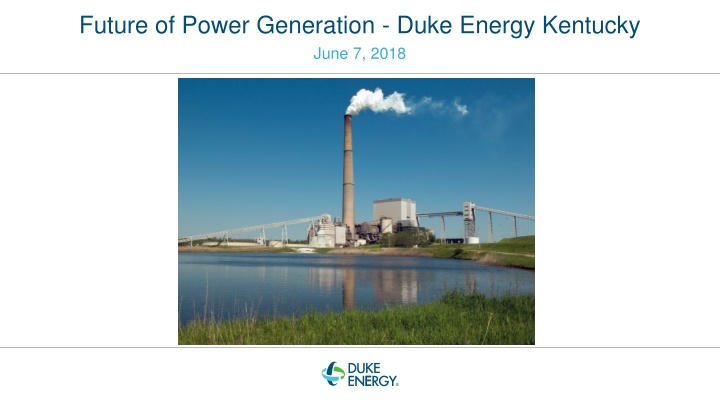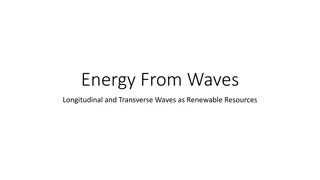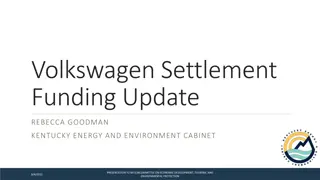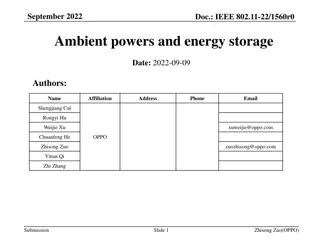Future of Power Generation - Duke Energy Kentucky
In June 2018, Duke Energy Kentucky discussed the drivers of change in power generation, including the impact of various factors like CO2 taxes, gas prices, and coal prices. The presentation highlighted the importance of balancing resources and making strategic additions and retirements to meet long-term economic goals. It also emphasized the benefits of renewable resources in reducing CO2 emissions, providing fuel cost stability, and promoting generation diversity.
Download Presentation

Please find below an Image/Link to download the presentation.
The content on the website is provided AS IS for your information and personal use only. It may not be sold, licensed, or shared on other websites without obtaining consent from the author.If you encounter any issues during the download, it is possible that the publisher has removed the file from their server.
You are allowed to download the files provided on this website for personal or commercial use, subject to the condition that they are used lawfully. All files are the property of their respective owners.
The content on the website is provided AS IS for your information and personal use only. It may not be sold, licensed, or shared on other websites without obtaining consent from the author.
E N D
Presentation Transcript
Future of Power Generation - Duke Energy Kentucky June 7, 2018
Agenda Duke Energy Kentucky System Drivers of Change Rationale for Additions and Retirements Expected Changes with respect to various generation types 2018 IRP to be submitted June 21, 2018 2
Duke Energy Kentucky System Peak demand: 841 MW (2018) Annual energy: 4,358 GWh (2018) Generation Baseload : East Bend 2 (600 MW coal fired) Peaking: Woodsdale (476 MW gas fired with oil back up in 2019) Solar: Crittenden & Walton (7 MW solar) 3
Drivers of Change DRIVER LIKELY IMPACT Decreases capacity factor of coal units; reduces CO2 emissions; increases market purchases CO2 Tax enacted Increases power prices; increases capacity factor of coal units; CO2 emissions increase; market purchases decrease High Gas Prices Decreases power prices; decreases capacity factor of coal units; CO2 emissions increase; market purchases increase Low Gas Prices Decreases capacity factor of coal units; increase in power prices; decrease CO2 emissions; increases market purchases High Coal Prices Increases capacity factor of coal units; reduction in power prices; increase CO2 emissions; reduces market purchases Low Coal Prices Accelerates addition of renewable resources; reduces CO2 emissions and market purchases Lower Cost of Renewables High Load Accelerates resource additions Low Load Delays resource additions 4
Rationale for Additions and Retirements Resource additions or retirements are made when they improve the long term economics for customers. Reserve margin is a minimum requirement of a generation fleet Add a resource when the overall, long term benefits of a project exceed its costs Retire an asset when the long term benefits of replacement exceed the costs of retirement Renewables can be added for the above reasons but also provide the following benefits: CO2 free generation Reduces fuel cost volatility Provides generation diversity The intermittency of renewables makes them less valuable for serving peak demand 5
Expected Changes with respect to various generation types RESOURCE TYPE EXPECTED CHANGE OVER NEXT 10 YEARS Coal Continued operation of well controlled units; CO2 tax puts coal units at risk Plausible replacement of retiring coal generation; emits CO2 at approx. 35% of the rate of coal generation Gas - CC Gas - CT Continued operation of Woodsdale peaking facility Nuclear No development expected Renewables Increasing development over time Purchase Power Made opportunistically as economics dictate 6
Key Takeaway East Bend 2 will be the primary generation source for the next 10 years DEK continually evaluates low cost coal for customers and looks for opportunities to burn coal from new KY operations Renewables (solar & storage) will be added to: Increase diversity of the generation fleet In response to the demands of existing customers Increase ability to attract new business to Kentucky 7























